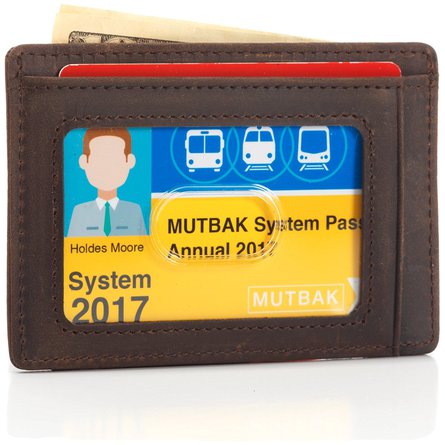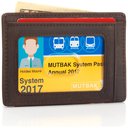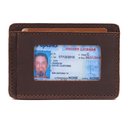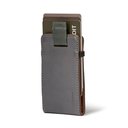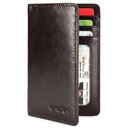What to Consider when Deciding on a Men’s Credit Card Wallet
If you’re browsing for a new credit card wallet, you’ll want to ensure that you’re getting one that’s durable and can last long enough to make the purchase price worth it. It also needs to feature the capacity and design elements that meet your specific needs. With so many wallets and wallet companies out available, there’s no need to settle for anything less than a wallet that you’re going to be completely happy with for the long haul.
Our buying guide will help you know what to look for, clarifying what marketers mean when they use certain phrases and making you aware of some design flaws you might want to avoid. We’ll tell you what to look for in a leather wallet and then broaden our scope to some alternative materials. We’ll also discuss branding and pricing as we give you our philosophy on making a final purchase.
Materials
Your wallet needs to be made of materials that will last. Otherwise, your wallet will fail as soon as the weakest element does. Here, we’ll tell what to look for in the primary material of a wallet, its exterior. In the next part of our buying guide, we’ll discuss the stitching, lining, ID window, bands, and other materials that a wallet often includes. Let’s take a look at leather quality first and then explore some of the other elements that a men’s credit card wallet might be made of.
Leather Quality
Every wallet package or product description should give you some information about the type of leather the wallet is made of. Some common keywords are full-grain or top-grain, genuine or bonded leather, faux leather, vegan leather, or koskin. Full-grain leather is the most authentic, but top-grain leather is as durable. We don’t recommend buying the others, and we’ll tell you why.
When we say that full-grain leather is the most authentic we’re referring to the fact that full-grain leather does not alter the natural markings and pore pattern of the originating animal’s hide. It shows their birthmarks, color variations, injuries, branding marks, and mosquito bites. The pore pattern will be different on every piece of hide and will most likely appear non-uniform across the length of the wallet. These markings and pore pattern variation makes every part of full-grain leather unique.
The style is mainly for those who enjoy being rustic or manly. It’s not necessarily fashionable, so it might not be the right look for a working professional or a corporate businessman in non-agricultural or industrial sectors. Full-grain leather is very durable, though, each piece being able to last more than 100 years. It keeps its shape the entire time, so if you consider yourself a connoisseur, you’ll appreciate full-grain leather.
The more fashionable choice is top-grain leather. It’s just as durable, but the appearance of the leather has been modified to look a little cleaner and more uniform. You might say it’s perfected, made to look like new. To achieve the look, manufacturers sand the top layer of the leather, removing the natural markings and textures. Afterward, they will either emboss the leather with an artificial surface or pattern or leave it smooth. It provides a trendy style for men’s credit card wallets as the leather appears to be from an unblemished hide. It’s for those who want the look of a new wallet without the natural character of full-grain markings.
Now we come to genuine and bonded leather. It’s also sometimes called split leather. It’s the least expensive type of leather for a good reason. It’s leather – made from animal hide – but it’s made from the bottom layers of hide instead of the top like full-grain, and top-grain leather is. It’s the same material you would make suede or nubuck out of, not durable for the outer layer of a wallet. The “split” term connotes the process of removing the bottom layers from the top. Bonded leather is even worse than genuine leather. It’s scraps of the suede material glued into sheets to make it usable again. Manufacturers use the terms “genuine” and “bonded” to make the material sound better than it is.
To make genuine and bonded leather more durable, and to give it the appearance of top layer leather, they emboss a pattern into it and coat it with polyurethane. The polyurethane only works for a little while though. Within two years of purchase, the polyurethane coating on a genuine or bonded leather men’s credit card wallet will start to crack, exposing the leather underneath. When that happens, the leather material in that area will break down very quickly.
Split leather can be made beautiful, and it’s even more attractive for its low price, but it can’t be made to be very durable. Our advice is to stay away from it. Even inexpensive wallets made of genuine or bonded leather aren’t worth the money.
Koskin, another name for vegan or faux leather is, of course, not leather in any original sense of the word. Like split leather, it’s material coated in polyurethane and made to look like animal leather. The underlying material might be durable itself, such as nylon or polyester, or less durable as in the case of cotton, but the polyurethane doesn’t do it any favors in the long run. It still cracks and mars the appearance it was meant to give. If you don’t want to use leather, it would be better to buy a nylon wallet without the polyurethane material on top of it.
Some wallet manufacturers don’t advertise which type of leather they’ve used. If that’s the case, you can safely bet that the leather is low quality genuine or bonded. The manufacturer has caught onto the fact that people are starting to recognize these terms as cover-ups for poor quality, so now they’re not using them, opting to say nothing at all and make you guess.
Any wallet manufacturer would be proud to tell you that their products are made from high-quality leather – full-grain or top-grain. Those who deal in faux leather are proud to do so because they feel they are more animal-friendly. No company is proud of using split leather. They know how long it will last. They’re just hoping you don’t or that you don’t ask what type of leather their wallet is made from.
Now that you know the terms, you can see around the various marketing phrases or lack of information and purchase a wallet that will last more than the 1-3 years that a split or faux leather wallet will.
Of course, you should expect to pay more for higher quality. Full and top-grain leather is more expensive because it’s made from the top layers of animal hide. You can’t use the more abundant supply of bottom layers, and you can’t use scraps. It also takes more time and more skill to tan high-quality leather. Because it is the superior product, it’s in higher demand by trusted wallet makers. Higher demand means higher prices. We’re not saying that a genuine or full-grain leather wallet should cost an exorbitant amount, only that it will be rightly priced as more expensive than split or faux leather options.
The bottom layers of hide are plentiful and easy to work with. Synthetic materials can be made in large quantity for relatively low costs. Polyurethane is not an expensive industrial chemical. You shouldn’t pay high-quality prices for low-quality and low-cost materials. In fact, there’s no reason that a split or faux leather wallet should cost more than $10. If it does cost more, it’s because they’re relying on a particular feature or design to sell the product. Our advice is to pass and look for a wallet made of full or top-grain with a similar style. Buying a low-quality product is a waste of money.
Leather Tanning
Tanning is more than coloring leather, as some people think. It’s the entire chemical process of transforming an animal rawhide into leather. The primary step is accomplished using tannins. These chemicals can be plant-based tannins or chromium tannins.
Plant tannins are used for making vegetable-tanned leather. It’s one of the original tanning methods. There’s also a slightly more interesting method called brain tanning. Leather that’s brain-tanned doesn’t last as long, and it isn’t as economical as using plant tannins or chromium.
Chromium tanning was borrowed from the medical industry. In 1840, researchers found that sutures last longer in the human body when soaked in chromium. Leatherworkers soon adopted the practice, and it is now the most economical method of tanning.
Because it takes longer to tan with plant-based materials, vegetable-tanned leather is often the more expensive of the two primary methods. It’s also the most susceptible to spotting and water damage. If you buy a vegetable-tanned leather wallet, be careful not to get it wet. If water or any other liquid penetrates the material, it will create dark watermarks. The marks might fade but will never go away completely.
Chrome-tanned leather will also stain when wet but not as bad. Potential water damage shouldn’t sway your decision too much when selecting a men’s credit card wallet, but if you’re torn between a chrome-tanned and a vegetable-tanned wallet, choose the chrome-tanned option.
Leather Thickness
Getting a low-quality full-grain or top-grain leather wallet is possible. After all, the material needs to be thick enough to not wear through from the simple act of sliding it in and out of your pocket.
If you’re shopping physical stores, you can pick up each wallet and feel the thickness of the layers. If you’re not in a store but browsing the internet for a wallet, you can watch Trevor check the thickness of each leather wallet we review.
Leather varies in thickness because no wallet manufacturer uses the entire depth of an animal hide. Animal hides are too thick for that. You couldn’t work with such a deep material. Therefore, they split the layers. A high-quality leather shop will use more of the top layers but not all of it, not so many layers that they can’t make a slim, foldable wallet out of it. As we’ve discussed, low-quality leather shops use the bottom layers in varying thicknesses and then coat it with polyurethane.
You can tell if a wallet is too thin by standing it up vertically. If the wallet starts to sag or falls, the leather is not thick enough to maintain its shape under its weight. You can also pinch the layers between your fingers and thumb. Feel along the length of the wallet. If you feel any hard inserts, the leather has been reinforced with secondary materials. Manufacturers place cardboard or plastic inserts in the lining to keep the wallet looking sturdy. On the downside, the inserts themselves rub against the thin leather, causing it to wear through even faster. If you find a wallet with too thin leather, consider it a deal breaker and keep looking.
In most cases, thin leather comes in a wallet made of genuine or split leather. The manufacturer has cut costs with low-quality leather and is now trying to make that leather go even further by using as little of the material as possible.
Thicker wallets will most likely be made from full or top-grain leather. Because of that, and because the manufacturer has used more material in their wallet, they should be paid more for their product. If they had opted to use fewer layers, they could have sold the remainder to a secondary leather shop. Instead, they chose to make a more durable product and charge a little more for it. Paying the higher price rewards them for using thicker materials in the wallet you want to buy.
Leather Scent
You can’t mistake, and you can’t fake, the natural smell of real leather. If you’re in the store looking for wallets, pick the wallet up and smell it. It shouldn’t smell like chemicals, but it should have a scent. Real leather will always carry an odor, even after it’s been in your pocket for years. A wallet that smells of chemical odors is most likely split leather that has been overly processed and coated in polyurethane.
If you’re shopping online, you can watch our video reviews to see Trevor do the sniff test on each model of wallet. Of course, you can expect the smell to reflect the price. Leather that carries the familiar scent should be a higher-quality product that doesn’t need polyurethane or other thick finishes. It will cost a little more than cheap leather that smells like a factory.
Leather Feel
The final method you can use to test the quality of leather in a men’s credit card wallet is to feel its surface. Most high-quality leather wallets will be smooth but not slick. They should still have some texture to them and not feel like melted plastic or wax. If it does, it’s another sure sign that the leather is of the split variety.
A men’s credit card wallet that feels the way leather should cost more than plastic coated wallets. The feel is evidence of high-quality leather and is therefore worth an increase in price over cheaper models.
Nylon
Leather is the primary material you’ll see in our reviews, but you can also find fine quality wallets made out of other materials. Nylon is a durable, flexible option for wallets. It’s a thin, bendable thermoplastic that won’t crack. It’s also an inexpensive, synthetic material, making nylon wallets very affordable. We can’t say that they’re the most fashionable choice, but they do have the advantage of not being damaged or stained by water. Nylon wallets will absorb water but dry out nicely.
You might want a flexible nylon wallet for exercising or playing sports. They’re not a professional or mature men’s wallet for everyday use. Young men frequently use them, though, and they can look very small and trendy.
Polycarbonate
The second thermoplastic that you’ll see some new wallets made out of is polycarbonate. It’s a durable material that keeps its shape. It’s often used for shell-type wallets. They might have a band securing the top and bottom shell plates together, or they might have a hinge and clasps holding it closed. A men’s credit card wallet made of polycarbonate will not be a comfortable item to sit or stick in your front pocket. You would most likely keep it in your bag or use it as a jogging wallet strapped to your wrist.
Like other synthetic materials, polycarbonate is an economical material to manufacture. Wallets made out of it will be less expensive than top layer leather wallets.
Construction
The outer or primary material is not the only material used in a wallet. The secondary elements are as essential when selecting a wallet. A high-quality leather wallet will fall apart if the stitching unravels or the money clip doesn’t clamp down. Let’s take a look at the secondary materials and give you an idea of how to tell the differences in quality.
Stitching
Leather and nylon wallets men’s credit card wallets should be held together by stitching. If it doesn’t have stitching, it’s held together by glue. Run away from it. Adhesives won’t last on any material that has to bend or fold. They’ll fall apart within a few months, no matter how sturdy or stylish they look.
The best type of stitching is done with nylon or polyester threading. Both materials are incredibly durable, even in water. They won’t loosen when sewn and they won’t fray. Cotton is also a standard threading material but isn’t as durable. It’s not a bad choice, but be sure to check that the threads are double stitched to reinforce the wallet’s construction. Cotton is the default if a manufacturer doesn’t tell you what type of threading material they’re using. Otherwise, they would advertise their use of polyester or nylon as they know that they’re the superior choices.
All high-quality men’s credit card wallets should be double stitched, especially around the sides of pockets where the threading gets stressed from cards lifting the material. You might also see stitching sewn in an X or cross pattern. It’s another way of reinforcing the stitching and can look neat on certain types of wallets. It’s not the most mature look though, so be sure that it’s going to fit your style before you buy it.
Finally, the stitching should have melted ends to hold the threads together. It prevents them from fraying or loosening and is evidence of a professional, finished product. If you see a wallet with tied-off stitches or stitches that loop back under the threading, be wary. They’re likely to come undone, and once a wallet’s stitching starts unraveling, you’ll either have to fix it yourself or send it in for repairs.
Lining
Next, you’ll want to check the lining. Manufacturers might skimp on the material forming the back of the pockets. A card with a rough edge can tear through some lining materials. Other materials are too thin and pull away from the stitching after a couple of months of handling.
The most common materials are cotton, silk, suede, polyester, nylon, and pigskin. Pigskin and suede, being types of leather in themselves, are durable, attractive choices. Suede should never be used on the outside of a wallet if you want it to last but is ideally suited the interior lining of a wallet. Polyester and nylon are also good choices. They can be patterned or left plain to complement the look of the wallet. Cotton and silk fabric is more questionable. Silk might feel the nicest but will be the easiest to tear. Cotton is the least expensive but can last quite a while if the lining is thick enough. It will start to snag on the corners of cards though so that it will be a weak point in the wallet’s construction.
The lining needs to be stitched as well as the outside pockets. Look down the pocket to ensure that the stitching doesn’t run across the front of the lining or extend into the interior of the pocket from the edges. Exposed threads like that will snag on cards. The cards will be more difficult to slide in and out of place, and the threads themselves will wear through, causing the stitching to unravel the lining.
Clips, Snaps, Hinges, and Hardware
Your men’s credit card wallet might come with extra hardware components. If it has a money clip, test how many bills it can hold without loosening up. Slide it around to see how much it moves and how secure the magnetic connection is. Examine how well the clip is secured to the wallet. If it has a spring, open and close it a few times to make sure it has tight but smooth action. If it winds down, tighten and loosen it to get a feel for how sturdy how the mechanism is. You can’t risk your bills on a shoddy clip.
If the men’s credit card wallet you’re interested in has snaps or hinges, open and close the wallet a few times. Check how much of a gap there is between the closed panels of the wallet. Could anything slide out? Are the hinges and snaps tight, taking some force to close or open the wallet, or are the connections loose enough that the closed wallet is likely to open on its own?
If the wallet has chainrings, look at the metal on both sides of the flap. It should completely cover the leather surrounding it, not showing any gaps or breaks in the metal. It should also be tight in the hole. Rotating it in a circle is okay, but there shouldn’t be a wiggle room from side to side or top to bottom. The leather should be reinforced around the chainring with double stitching to ensure that the hole doesn’t widen and the leather or nylon doesn’t stretch or tear when you pull on the chain.
If you’re looking at a polycarbonate wallet with a button release, work the lever a few times. See if you can move it back and forth. Examine the spring to see how securely it’s seated.
Loose or flimsy hardware can ruin an otherwise well-constructed wallet. The features that they’re meant to bring to the wallet become useless, making one of the wallet’s major selling points worthless.
Zippers
If you’re looking for a security wallet, you’ll come across quite a few models with zippers. A well-made zipper is tight opening and closing, and it closes all the way to the end. There shouldn’t be any teeth left separated at the end. If the zipper is a little difficult to pull open and closed, that shows that the teeth are making strong connections. You don’t want a zipper that could open on its own with the slightest bit of movement.
Zippers should also be double stitched all along the sides of the fabric. You’ll be putting stress on the structure as you pull the zipper, so the stitching needs to be strong enough to ensure that it won’t pull away from the wallet’s material.
Plastic and Elastic
Plastic and elastic are notorious offenders for ruining a perfectly good wallet. Elastic bands and plastic ID windows are some of the first components to fail. They’re used as convenience features, such as for showing a driver’s license, work badge, or student ID without having to pull the card out its pocket. Elastic bands hold quick-access cards or cash to the outside of the wallet, or they’re used for pull-tabs in deep pockets for cards.
But how useful is a plastic ID window when it dents, cracks, or pulls away from the lining? How useful is a quick-access elastic band when it stretches out or gets a snag in it and starts ripping? Pull-tabs won’t pull out your cards if they tear or break.
The best wallets, in our opinion, place the plastic ID windows on the interior fold of the wallet where they won’t wear as quickly or feature no-plastic ID windows. There’s just an opening in the leather or nylon. The card is protected by being recessed from the surrounding surface of the wallet.
We would also advise staying away from elastic bands, particularly those that hold a wallet closed. Pull-tabs are thicker and therefore more durable, but simple wallets with open pockets are still a wiser investment. Fewer features in a wallet make it more durable. There’s less to break.
Craftsmanship
After checking the wallet for material and construction durability, the next item on your inspection list should be the craftsmanship (how well the wallet maker used their quality materials to make the wallet). You can tell if they took shortcuts or took pride in the products they were creating. The cuts, edges, and corners are tell-tale signs of excellent or shoddy craftsmanship.
Cuts
Inspect the edges of the cut materials. Do they look even all the way across? Are they straight compared to the other cuts on the wallet? A pocket or edge shouldn’t have any wavy lines in it, and it should be perfectly perpendicular or parallel to the rest of the lines of the wallet.
Pocket Edges
Now, take a look at the pockets. Are the tops cut off or does the material fold down the inside of the pocket or roll over the front?
A folded over pocket should have material extending down the full length of the pocket so that cards can’t snag on the edges of the fold. If the fold stops partway up, the lip of the material will also get in the way of pulling cards out of the pocket.
A pocket cut straight across should feel thick and have enough material to keep its shape, not bowing or sagging at the top of the pocket.
Also, check the thickness of a rolled over pocket. Sometimes, manufacturers turn thin leather over to make a more stylish design. While it does look nice, it doesn’t change the fact that the leather of the pocket is too thin to be durable. A leather wallet with rolled over edges where the leather is nice and thick is another story. It takes an artisan a lot of time to shave the top of the pocket and roll it over while keeping the rest of the pocket thick enough for durability. You can expect thick rolled over pockets to increase the price of the wallet.
Corners
The last part of your inspection are the corners and edges. When you look at the side, can you see the different layers of leather or nylon stacked on top of one other? It will look like a flight of steps climbing the length of the wallet. It seems very rustic and homemade. It doesn’t show excellent craftsmanship, however, and will lead to the deterioration of the material.
Instead, you should look for wallets that have a smooth edge where the wallet maker has thinned the material at the sides and blended the edges. The corners should also be rounded off to keep them from crumpling or turning down like dog ears.
One shortcut to look out for is an added bonding material coating the edges to make them look smooth. Like the polyurethane that cracks on split leather, this type of bonding material cover-up will crack and then start peeling away from the edge of the wallet. If you have a leather wallet, the sides underneath the bonding material will not only look uneven again but will also have a lighter color than the rest of the wallet because that area hasn’t aged with the rest of the leather.
The highest quality wallets have straight and parallel cuts, straight cut or rolled pockets, and blended edges.
Warranty
Check the length of the warranty. You might see a high-quality wallet manufacturer off a 100-year warranty or no warranty at all. Others offer warranties for up to 3 years. Notice that we said these are all from high-quality manufacturers. So, why such a range?
If a manufacturer offers a 100-year warranty, they’re telling you that their wallet will last that long. If they provide no warranty, they’re saying that you don’t need one. Their wallet will last. If they offer a 1-3 year warranty, they’re telling you that they stand by their product but don’t want customers coming to them 50 years later to fix an unraveling thread.
All three are valid, but we’re most comfortable with warranties of at least year. That gives you a chance to use your wallet and ask for repairs if you do find anything wrong with it.
What you should look out for are very short warranties of 6 months or less or no-questions-asked money-back guarantees. A very short warranty shows that the manufacturer can’t stand behind their product beyond that length of time. They know that it won’t last very long and are giving you a warranty that they can feel safe with. After the warranty expires, you might as well throw the wallet in the trash because that’s when it’s going to start breaking down.
When a manufacturer offers money-back guarantees versus a warranty, they’re showing that they know their product is cheap and would instead give you your money back than try to repair a low-quality product. If they say they won’t ask questions about why you’re returning it, they’re also hoping you won’t ask questions as to why they made such an inferior product.
If you suspect the wallet is low quality based on materials or craftsmanship and they offer a short warranty or money-back guarantee, let that confirm your suspicions. If the wallet seems to be high quality, don’t let the length of the warranty be a determining factor in your decision. Warranties of 1-3 years offer plenty of time to return for defects. More than that is just marketing, telling you how durable the wallet will be.
Size and Weight
If the wallet materials and craftsmanship look right, you can start thinking about how you’re going to use your wallet. First, you’ll want to think about how comfortable the wallet will be and how much you need it to hold. You’ll also want it to fit in your pocket loosely enough to pull it out when needed.
A leather or nylon men’s credit card wallet that measures approximately 3.5 inches tall by 4.5 inches wide will give you enough room to insert crisp, unfolded bills in the cash pocket and have an ample number of card pockets. This size will fit comfortably in a back or front pocket without creating too much of a bulge in your clothing.
Those measurements should also be small enough to make the wallet weigh less than 75 grams empty so that the weight of it doesn’t make your pants sag. Be wary of men’s credit card wallets that weigh less than 40 grams though as that might be an indication of too thin material or too few pockets.
Capacity
Before you judge a wallet’s capacity, re-examine the number of cards and how many bills you need to keep on you on a daily basis. You might have cards in your wallet that you don’t use anymore or use only rarely. You might be able to digitize some of the information on your cards or use electronic payment methods instead of cards or cash. Read our blog post on How to Reduce the Contents of Your Wallet for more information on the topic.
Once you’ve taken out as much as you’re going to, you can take a realistic look at the capacity of different wallets. You can also consider the layout of pockets. You might want the traditional arrangement of card pockets holding 2-3 cards, or you might enjoy a large pocket or pull tab that holds all of your cards in one area. You can decide if you like exterior pockets or quick-access bands. Be sure to think about what is likely to break or expose cards that you don’t to wear.
Features
Besides the standard considerations of cash and cards, do you need your wallet to have any other features, such as an ID window, the ability to add inserts, a coin pouch, a pocket for keys or SIM cards, separate receipt pockets, zippers? Think about how you want to use your new men’s credit card wallet and the features that you wish your current wallet had. If you can think of your ideal wallet, you can probably find something very similar. Keep in mind, though, that simpler is often more durable, having fewer parts and pieces to wear or break.
RFID Protection
All modern cards digitally store financial, personal, or access code information that can easily be read through your clothes and the lining of your wallet. They operate on radio frequencies at card readers, but can also be read using the same technology when you’re not aware of it.
To protect the information on your cards and to prevent others from using your cards for unauthorized purchases or illegally entering a key-coded area, you can store your cards in a wallet with RFID (radio frequency identification) protection. This protection comes in the form of a thin, light metallic mesh insert in the lining of your wallet.
You can choose to purchase a wallet that blocks financial and personal information only, accessed with a radio frequency of 13.56 MHz or one that prevents both that and the 125 kHz frequency for older proximity access cards. Many wallets also have pockets that block the first but not the second so that you can arrange your wallet in the most convenient manner.
Unfortunately, many wallet makers are still not making RFID protection a priority. If you want to purchase a wallet without it, consider adding RFID sleeves to your wallet. You can use them with any card, but they will add to the thickness of the card, reducing the wallet’s overall capacity.
Design
Some wallet manufacturers take such great pride in their brand that they want you to as well. And you might as well advertise for them every time you pull out your wallet. That’s the message of wallets with large logos.
If you do enjoy a brand or think the design is fashionable, consider whether you’ll still have the same opinion years from now. Hopefully, your wallet will last that long, but the brand’s popularity might not. We recommend buying a high-quality wallet with small designs.
Purchase Options
Whether or not you want a large design or logo on your wallet, you will probably recognize that quality is not the only factor in purchasing a wallet. Even high-quality leather can be dyed any color, so you’re not limited to black or brown. Most wallet designs come in at least two colors, and many come in much more than that. Choose the color that goes with your style and that you can feel comfortable using in any setting.
Packaging and Gift Boxes
If you’re shopping online, try to find out how the wallet will be shipped. The best practice is to put the wallet in a smaller box inside a larger box with protective stuffing. That way, the wallet is sure to arrive undamaged.
When you’re purchasing a men’s credit card wallet as a gift, see if the company sends the wallet in a gift box and try to find an image of the box. Some companies send a gift box that’s nothing more than a dull box or cardboard envelope. They help make wrapping the wallet more natural, but they’re not what we would call gift boxes. Others send a decorative box that you don’t even need to wrap. Such boxes make classier gifts as they show the quality of the present given.
Price
More is better if you’re talking about higher quality and longer durability. A wallet with those characteristics should also be more expensive. You can spend a little more and buy a high-quality wallet that you’ll possibly never need to replace or you can purchase low-quality wallets at dirt cheap prices that you’ll need to replace in a year or two. Our advice is to pay for a wallet that you’ll be happy with longer.
At the same time, you shouldn’t pay more for a high-quality men’s credit card wallet just because it was made by a well-known brand. If you’ve examined a wallet from a smaller manufacturer and found it to be of the same quality as the larger company but available at a lower price, there’s no reason not to buy it. Every company starts small. If they make good products, they’ll grow.
Conclusion
Which is the best credit card wallet for men? For traditional layout, durability, capacity, and overall convenience, we picked Saddleback Leather. The GintaXen is a very close competitor with slightly downgraded leather and a relatively big price drop. For minimalism matched with top-grade leather, we always enjoy Mutbak products. If you're looking for innovation and modern style, try the Distil Union or Radix One.
